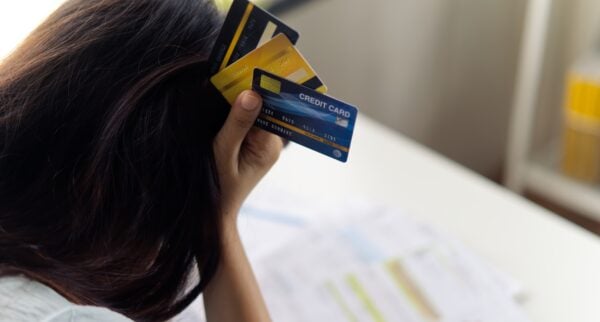
Are you struggling with credit card debt, or looking to improve your financial security?
Now that tax filing season is behind you, help may be on the way.
If the 2024 tax year is anything like the prior one, you may be one of millions of Americans who receives a substantial refund. You might be tempted to use that nice chunk of change for a major purchase. However, if you want to make the most of your tax refund, one of the best things you can do is use it to pay down high interest credit card debt.
This doesn’t have to mean sacrificing what you want to buy for the sake of financial security. In the long run, getting rid of that high-interest credit card debt should leave more money in your pocket for the things you want.
How reducing your debt can maximize your tax refund
By the time most 2023 tax year filings were completed, more than 100 million taxpayers were owed a refund. The average size of those refunds was $4,265.
That type of money makes a nice addition to your bank account. It also represents a serious financial responsibility. How can you make the most of that refund? Consider how much more that money would be worth if you use it to pay down credit card debt.
The most recent CardRatings.com credit card interest rate survey found that the average credit card charges an interest rate of 24.3%. So, let’s say your refund this year is the same as the average for last year. Here are three options:
- You could spend it, getting a total of $4,265 in goods or services out of it.
- You could put it in a savings account. According to the FDIC, the average savings account pays an interest rate of 0.41%. So, over the next year, $4,265 would earn about $17.49 in interest for a total value of $4,282.49.
- You could use it to pay down credit card debt. In addition to reducing your debt by $4,265, based on the average credit card rate, you’d also save about $1,036.40 in interest charges over the next year. That would bring the total value of your refund to $5,301.40.
Spending money can be fun, but assuming you’d rather have $5,301.40 than $4,265, isn’t it worth considering using that refund to pay down credit card debt?
Using your tax refund to pay down high-interest credit card debt
One reason credit card debt is so expensive is that it often tends to last a long time.
A recent study by the Federal Reserve Bank of Philadelphia found that the proportion of credit card accounts making just the minimum payment is at the highest level since they’ve been tracking that statistic. One problem with that is that making no more than the minimum payment on each bill means that your debt could take a few years to pay off – and that’s if you don’t have any new charges. If you continue using the card, you’re likely to see the debt go up over time rather than down.
At high interest rates, continually carrying credit card debt is very expensive. Another problem with so many people paying just the minimum is that it suggests they’re close to the financial edge. Any kind of setback could mean they can’t afford to keep up with their payments. That would only add late fees to the expense of their debt.
➤ SEE MORE:Should you prioritize paying off credit card debt over setting up an emergency fund?
Getting a tax refund is a great opportunity to break the cycle of continual debt by paying your balance down faster. Instead of chipping away at the problem month by month, using your tax refund to pay down high interest credit card debt allows you to smash a large hole in it all at once.
If you have balances on multiple accounts, the best way to pay down credit card debt with a tax refund is to prioritize your payments according to the interest rates on your cards.
List your credit cards by their interest rates, from highest to lowest. Make the minimum required payment on each one every month. Then use any extra money to pay down the balance on the one with the highest interest rate. If you have money left over after paying off that balance, move on to the next highest, and so on.
Prioritizing your payments this way will have the biggest impact on reducing interest charges in the months ahead. That way, more of your future payments can go towards reducing the principal rather than paying interest. That further accelerates paying down debt.
➤ SEE MORE:How to eliminate credit card debt
Credit card interest magnifies inflation
Despite widespread concerns about the economy, consumers went on a spending spree in March. Retail spending surged by 1.4% during the month. The reason? Economists speculate that it was because people wanted to get major purchases in before new tariffs start affecting prices.
While that may sound sensible, it’s only a smart money move if you don’t have credit card debt. Even in high inflation periods, credit card rates generally exceed the rate of inflation. So, it’s likely you’ll still save more by paying down credit card debt than by buying in advance of tariffs.
Side benefit: Paying down debt can improve your credit score
Besides the money you’ll save on interest and the financial stability you can achieve by eliminating debt, there’s one more benefit of using a tax refund for debt reduction instead of spending.
The amount you owe affects about 30% of your credit score. Both the dollar amount and that amount as a percentage of your available credit matter. The lower they are, the better. Using a tax refund to pay down credit card debt can reduce both these numbers and thus improve your credit score.
➤ SEE MORE:How much of your credit should you use?
A better credit score may allow you to qualify for lower interest rates on future borrowing. This will improve your financial health by allowing you to use credit more affordably in the future.
So, resist the temptation to rush out and blow your tax refund all at once. That’s just a one-time thrill. Using that refund to pay down credit card debt can have lasting benefits that will give you the money for more thrills in the future.


